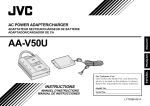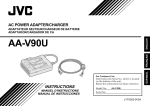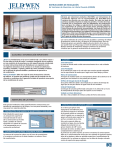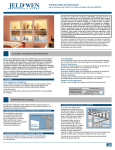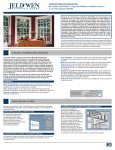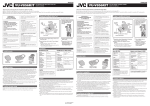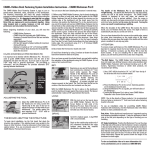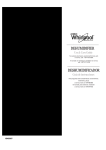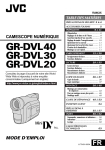Download JVC AA V20U User's Manual
Transcript
AC POWER ADAPTER/CHARGER ENGLISH ADAPTATEUR SECTEUR/CHARGEUR DE BATTERIE ADAPTADOR/CARGADOR DE CA For Customer Use: Enter below the Model No. and Serial No. which is located on the bottom of cabinet. Retain this information for future reference. INSTRUCTIONS Model No. MANUEL D’INSTRUCTIONS MANUAL DE INSTRUCCIONES Serial No. LYT0430-001A ESPAÑOL FRANÇAIS AA-V20U Thank you for purchasing the JVC AC Power Adapter/Charger. This unit provides DC power for the JVC Digital Video Camera from a household AC outlet. It can be used to recharge the JVC battery pack for exclusive use with the JVC Digital Video Camera. To avoid problems and obtain the best results, please read this instruction booklet carefully before use. Before using as a power adapter, make sure that this unit’s model number is the same as that of the power supply unit specified in the instruction manual of the equipment you wish to power. WARNING: TO PREVENT FIRE OR SHOCK HAZARD, DO NOT EXPOSE THIS UNIT TO RAIN OR MOISTURE. `, 60 Hz This unit should be used with AC 120 V` only in the USA and Canada. In other countries, `, this unit should be used with AC 110 – 240 V` 50/60 Hz only. CAUTION: To prevent electric shocks and fire hazards, do NOT use any other power source. CAUTION RISK OF ELECTRIC SHOCK DO NOT OPEN CAUTION: TO REDUCE THE RISK OF ELECTRIC SHOCK, DO NOT REMOVE COVER (OR BACK). NO USER-SERVICEABLE PARTS INSIDE. REFER SERVICING TO QUALIFIED SERVICE PERSONNEL. The lightning flash with arrowhead symbol, within an equilateral triangle, is intended to alert the user to the presence of uninsulated “dangerous voltage” within the product's enclosure that may be of sufficient magnitude to constitute a risk of electric shock to persons. The exclamation point within an equilateral triangle is intended to alert the user to the presence of important operating and maintenance (servicing) instructions in the literature accompanying the appliance. EN-2 CAUTION: TO PREVENT ELECTRIC SHOCK MATCH WIDE BLADE OF PLUG TO WIDE SLOT, FULLY INSERT. CAUTIONS: • If used near a radio, this unit may interfere with reception. • Prevent inflammables, water and metallic objects from entering the unit. • Do not disassemble or modify the unit. • Do not apply shocks to the unit. • Do not subject the unit to direct sunlight. • Avoid using the unit in extremely hot or humid places. • Avoid using the unit in places subject to vibrations. A WORD ON THE EXCLUSIVE BATTERY PACKS The battery packs are lithium-ion. Give attention to the following to make the most of their characteristics. For charging : 10°C to 35°C (50°F to 95°F) For operating : 0°C to 40°C (32°F to 104°F) For storing : –10°C to 30°C (14°F to 86°F) NOTE: The rating plate (Serial number plate) is on the bottom of the unit. USING HOUSEHOLD AC PLUG ADAPTER In case of connecting attached Power Cord Plug to AC wall outlet other than American National Standard C73 series type, use an AC plug adapter, so called “Siemens Plug”, as shown below. For this AC plug adapter, Plug adapter (optional) consult your nearest JVC dealer. This Class B digital apparatus complies with Canadian ICES-003. Cet appareil numérique de la classe B est conforme à la norme NMB-003 du Canada. INFORMATION This device complies with Part 15 of FCC Rules. Operation is subject to the following two conditions: (1) This device may not cause harmful interference, and (2) this device must accept any interference received, including interference that may cause undesired operation. Change or modifications not approved by the party responsible for compliance could void the user’s authority to operate the equipment. This equipment has been tested and found to comply with the limits for a Class B digital device, pursuant to Part 15 of the FCC Rules. These limits are designed to provide reasonable protection against harmful interference in a residential installation. This equipment generates, uses, and can radiate radio frequency energy and, if not installed and used in accordance with the instructions, may cause harmful interference to radio communications. However, there is no guarantee that interference will not occur in a particular installation. If this equipment does cause harmful interference to radio or television reception, which can be determined by turning the equipment off and on, the user is encouraged to try to correct the interference by one or more of the following measures: Reorient or relocate the receiving antenna. Increase the separation between the equipment and receiver. Connect the equipment into an outlet on a circuit different from that to which the receiver is connected. Consult the dealer or an experienced radio/TV technician for help. EN-3 CHARGING THE BATTERY PACK Battery pack BN-V207U or BN-V214U To AC outlet POWER indicator CHARGE indicator AC Power Adapter/Charger AA-V20U DC OUT connector EN-4 1 Make sure you unplug the camcorder’s DC cord from the AC Power Adapter/Charger. Plug the AC Adapter/Charger’s power cord into an AC outlet. The POWER indicator lights. 2 Remove the battery pack’s protective cap. Attach the battery pack with its long groove pointing toward the indicator side of the battery pack mount on the AC Power Adapter/Charger. The CHARGE Indicator begins blinking to indicate charging has started. 3 4 When the CHARGE indicator stops blinking but stays lit, charging is finished. Slide the battery in the opposite direction of the arrow and lift off. Remember to unplug the AC Adapter/Charger’s power cord from the AC outlet. NOTE: Perform charging where the temperature is between 10°C (50°F) and 35°C (95°F). 20°C (68°F) to 25°C (77°F) is the ideal temperature range for charging. If the environment is too cold, charging may be incomplete. Battery pack Charging time BN-V207U approx. 1 hr. 30 min.* BN-V214U approx. 3 hrs.* * When charged at temperatures between 20°C (68°F) and 25°C (77°F). •When charging Battery Packs after a long storage period, charging time will be longer than the time indicated above. EN-5 SUPPLYING POWER You can connect the camcorder to an AC outlet using the AA-V20U AC Power Adapter/Charger. To DC IN connector Core filter AC Power Adapter/Charger AA-V20U To AC outlet DC cord To DC OUT connector EN-6 1 2 Plug the AC Adapter/Charger’s power cord into an AC outlet. Connect the AC Adapter to the camcorder. NOTE: When using the provided DC cord, make sure you connect the end of the cable with the core filter to the camcorder. The core filter improves performance of equipment. DURING USE . . . ● The AC Power Adapter/Charger AA-V20U is specifically designed to charge BN-V207U and/or BN-V214U Battery Packs. ● When charging a brand new Battery Pack, or one that’s been in storage for an extended period, the Charging Indicator may not come on. In this case, remove the Battery Pack, then reattach and try charging again. ● If you connect the DC Cord to the DC Connector while a Battery Pack is being charged, power will be supplied to the camcorder and charging will end incomplete. ● Vibration noise can sometimes be heard coming from the inside of the AC Power Adapter/Charger. This is normal. ● The AC Power Adapter/Charger processes electricity internally, and will become warm during use. This is normal. Make sure to use the AC Power Adapter/Charger in well-ventilated areas only. ● If the battery operation time remains extremely short even after having been fully charged, the battery is worn out and needs to be replaced. Please purchase a new one. SPECIFICATIONS Power USA and Canada AC 120 V`, 60 Hz Other countries AC 110 – 240 V`, 50/60 Hz Power consumption 23 W Output power DC 7.2 V DC 6.3 V Operating temperature 0°C to 40°C (32°F to 104°F) [when charging, 10°C to 35°C (50°F to 95°F)] Dimensions 68 mm (W) x 38 mm (H) x 110 mm (D) (2–11/16" x 1–1/2" x 4–3/8") Weight Approx. 255 g (0.57 lbs) , 0.77 A (charge) , 1.8 A (VTR) EN-7 Merci d’avoir acheté cet adaptateur secteur/ chargeur JVC. Il est destiné à fournir le courant continu nécessaire au camescope numérique JVC à partir d’une prise secteur. Il sert aussi à charger la batterie JVC prévue pour le camescope numérique JVC. Pour éviter tout problème et utiliser de manière optimale l’adaptateur/chargeur, veuillez lire les instructions de ce manuel avant utilisation. Avant d’utiliser un adaptateur d’alimentation, s’assurer que le numéro de modèle de l’appareil est le même que celui de l’appareil d’alimentation spécifié dans le mode d’emploi du matériel que vous voulez alimenter. ATTENTION RISQUE D'ELECTROCUTION NE PAS OUVRIR ATTENTION: POUR EVITER TOUT RISQUE D'ELECTROCUTION ATTENTION: NE PAS OUVRIR LE BOITIER AUCUNE PIECE INTERIEURE N'EST A REGLER PAR L'UTILISATEUR. SE REFERER A UN AGENT QUALIFIE EN CAS DE PROBLEME. FR-2 AVERTISSEMENT: POUR EVITER LES RISQUES D’INCENDIE OU D’ELECTROCUTION, NE PAS EXPOSER L’APPAREIL A LA PLUIE OU A L’HUMIDITE. Cet appareil doit être utilisé sur courant secteur `, 60Hz, aux Etats-Unis et au Canada. de 120V` Dans les autres pays, il doit être utilisé sur `, 50/60Hz. courant secteur de 110 à 240V` ATTENTION: Afin d’éviter tout risque d’incendie ou d’électrocution, NE PAS utiliser d’autres sources d’alimentation électrique. ATTENTION POUR ÉVITER LES CHOCS ÉLECTRIQUES, INTRODUIRE LA LAME LA PLUS LARGE DE LA FICHE DANS LA BORNE CORRESPONDANTE DE LA PRISE ET POUSSER JUSQU’AU FOND. Le symbole de l'éclair à l'intérieur d'un triangle équilatéral est destiné à alerter l'utilisateur sur la présence d'une "tension dangereuse" non isolée dans le boîtier du produit. Cette tension est suffisante pour provoquer l'électrocution de personnes. REMARQUE: La plaque d’identification (numéro de série) se trouve sous l’appareil. Le point d'exclamation à l'intérieur d'un triangle équilatéral est destiné à alerter l'utilisateur sur la présence d'opérations d'entretien importantes au sujet desquelles des renseignements se trouvent dans le manuel d'instructions. Cet appareil numérique de la classe B est conforme à la norme NMB-003 du Canada. PRECAUTIONS: • Si l’adaptateur/chargeur est utilisé près d’une radio, il peut provoquer des interférences sur la réception. • Evitez que des matières inflammables, de l’eau ou des objets métalliques ne pénètrent dans l’adaptateur/ chargeur. • Ne pas démonter ou modifier l’adaptateur/chargeur. • Ne pas exposer à des chocs. • Ne pas exposer en plein soleil. • Evitez d’utiliser l’adaptateur/chargeur dans des lieux extrêmement chauds ou humides. • Evitez d’utiliser l’adaptateur/chargeur dans des lieux exposés à des vibrations. A PROPOS DES BATTERIES Les batteries sont au lithium-ion. Tenez compte des informations suivantes pour profiter au maximum de toutes leurs caractéristiques. Température de recharge : 10°C à 35°C Température de fonctionnement : 0°C à 40°C Température de stockage : –10°C à 30°C UTILISATION DE L’ADAPTATEUR DE PRISE SECTEUR: Lors du branchement du cordon d’alimentation de l’appareil à une prise secteur différente du standard national américain C73, utiliser un adaptateur de prise CA nommé “Siemens Plug”, comme indiqué ci-dessous. Pour cet adaptateur de fiche CA, Adaptateur de fiche consulter votre revendeur (en option) JVC le plus proche. INFORMATION Cet ensemble se conforme à la partie 15 des règles de la FCC (Federal Communications Commission). Le fonctionnement est sujet aux deux conditions suivantes: (1) Cet appareil ne peut pas causer d’interférences nuisibles, et (2) cet appareil doit accepter toute interférence reçue, comprenant des interférences qui peuvent causer un mauvais fonctionnement. Des changements ou modifications non approuvés par la partie responsable de la certification peuvent annuler le droit de l’utilisateur de faire fonctionner l’appareil. Cet appareil a été testé et il a été reconnu qu’il se conforme aux limites concernant l’appareillage informatique de classe B correspondant à la partie 15 des règles de la FCC. Ces limites sont conçues pour garantir une protection raisonnable contre des interférences nuisibles dans les installations résidentielles. Cet appareil génère, utilise et peut émettre de l’énergie des fréquences radio et, s’il n’est pas installé et utilisé selon les instructions du fabricant, peut causer des interférences nuisibles en communications radio. Cependant, il ne peut pas être garanti que des interférences ne se produiront pas dans certaines installations particulières. Si cet appareil provoque des interférences avec la réception radio ou de télévision, ce qui peut être vérifié en alimentant l’appareil et en coupant son alimentation, nous conseillons à l’utilisateur d’essayer d’éliminer ces interférences par l’un ou plusieurs des moyens suivants: Réorienter ou déplacer l’antenne de réception. Augmenter la séparation entre l’appareil et le récepteur. Brancher l’appareil sur une prise de courant d’un circuit différent de celui sur lequel le récepteur est branché. Consulter le revendeur ou un technicien radio/TV compétent pour vous aider. FR-3 RECHARGE DE LA BATTERIE Batterie BN-V207U ou BN-V214U Témoin POWER Vers une prise secteur Témoin CHARGE Adaptateur secteur/chargeur AA-V20U Prise de sortie CC (DC OUT) FR-4 1 S’assurer de débrancher le cordon CC du camescope de l’adaptateur secteur/chargeur. Branchez le cordon d’alimentation de l’adaptateur secteur/chargeur sur une prise de courant. Le témoin POWER s’allume. 2 Retirer le capuchon de protection de la batterie. Monter la batterie avec sa longue rainure dirigée vers le côté indicateur de la monture de batterie sur l’adaptateur secteur/chargeur. Le témoin CHARGE se met à clignoter pour indiquer que la recharge commence. 3 4 Quand le témoin CHARGE cesse de clignoter mais reste allumé, la recharge est terminée. Faites coulisser la batterie dans le sens opposé de la flèche et enlevez-la. N’oubliez pas de débrancher le cordon d’alimentation de l’adaptateur secteur/chargeur de la prise de courant. REMARQUE: Effectuer la recharge où la température est entre 10˚ et 35˚C. 20˚ à 25˚C est la gamme de température idéale pour la recharge. Si l’environnement est trop froid, la recharge peut être incomplète. Batterie Durée de recharge BN-V207U Environ 1 heure 30 mn* BN-V214U Environ 3 heures* * En rechargeant à des températures entre 20˚ et 25˚C. •En rechargeant des batteries après une longue période de stockage, la durée de recharge sera plus longue que la durée indiquée ci-dessus. FR-5 FOURNITURE DE L’ALIMENTATION Vous pouvez raccorder le camescope à une prise secteur en utilisant l’adaptateur secteur/chargeur AA-V20U. Vers la prise DC IN Adaptateur secteur/chargeur de batterie AA-V20U FR-6 Brancher le cordon d’alimentation de l’adaptateur secteur/chargeur sur une prise de courant. 2 Raccorder l’adaptateur secteur au camescope. Filtre en ligne Vers une prise secteur Cordon CC Vers prise DC OUT 1 REMARQUE: En utilisant le cordon CC fourni, s’assurer de raccorder l’extrémité du câble avec le filtre en ligne au camescope. Le filtre en ligne améliore les performances du matériel. PENDANT L’UTILISATION . . . ● L’adaptateur secteur/chargeur AA-V20U est spécialement conçu pour la recharge des batteries BN-V207U et/ou BN-V214U. ● Quand vous rechargez une batterie neuve, ou une pile qui n’a pas été utilisée pendant longtemps, le témoin de charge peut ne pas s’allumer. Dans ce cas, enlevez la batterie puis remettez-la en place. ● Si vous raccordez le cordon CC au connecteur CC quand une batterie est en cours de recharge, l’alimentation sera fournie au camescope et la recharge sera partielle. ● Un bruit de vibration provenant de l’intérieur de l’adaptateur secteur/chargeur peut être audible. C’est normal. ● L’adaptateur secteur/chargeur produit de l’électricité et peut devenir chaud pendant la recharge. C’est normal. Assurez-vous que l’adaptateur secteur/chargeur se trouve dans un endroit bien aéré. ● Si la durée de fonctionnement de la batterie reste très courte même après l’avoir complètement rechargée, la batterie est usée et elle a besoin d’être remplacée. Veuillez en acheter une nouvelle. SPÉCIFICATIONS Alimentation Etats-Unis et Canada CA 120 V`, 60 Hz Autres pays CA 110 à 240 V`, 50/60 Hz Consommation 23 W Puissance de sortie , 0,77 A (recharge) CC 7,2 V CC 6,3 V , 1,8 A (magnétoscope) Température de fonctionnement 0°C à 40°C (pendant la recharge, 10°C à 35°C) Dimensions 68 mm (L) x 38 mm (H) x 110 mm (P) Poids Env. 255 g FR-7 Le agradecemos la adquisición de el adaptador/ cargador de CA de JVC. Esta unidad suministra CC para la cámara de video digital de JVC, proveniente de una toma de corriente alterna. Puede ser utilizada para recargar la batería JVC para uso exclusivo con la cámara de video digital de JVC. Para evitar problemas y obtener los mejores resultados, lea este librillo de instrucciones antes de utilizar la unidad. Antes de utilizarlo como adaptador de corriente, asegúrese de que el número de modelo de esta unidad corresponde con el especificado en el manual de instrucciones del equipo con el que quiere utilizarlo. ADVERTENCIA: PARA EVITAR RIESGOS DE INCENDIOS O ELECTROCUCIONES, NO EXPONGA ESTE APARATO A LA LLUVIA O HUMEDAD. Esta unidad debe ser utilizada con 120V`, 60Hz exclusivamente en EE.UU y Canadá. En otros países esta unidad debe ser utilizada con CA 110 – 240V`, 50/60Hz exclusivamente. PRECAUCION: Para evitar choques eléctricos y accidentes, NO utilice ninguna otra fuente de alimentación. ATENCION PELIGRO DE ELECTROCUCION NO ABRA ATENCION: PARA EVITAR RIESGOS DE ELECTROCUCION, NO EXTRAIGA LA CUBIERTA (O LA PARTE POSTERIOR). NO HAY PARTES REPARABLES POR USUARIO EN EL INTERIOR. EN CASO DE REPARACIONES, ACUDA AL PERSONAL DE SERVICIO AUTORIZADO. El rayo con punta de flecha dentro de un triángulo equilátero alerta al usuario sobre la presencia de “tensión peligrosa” sin aislación dentro del gabinete de la unidad, cuya magnitud constituye un riesgo de electrocución de personas. El signo de exclamación dentro de un triángulo equilátero indica al usuario que existen importantes instrucciones de mantenimiento (servicio) y operación en el manual que acompaña al aparato. ES-2 ATENCION PARA EVITAR ELECTROCHOQUES, NO UTILICE ESTA CLAVIJA POLARIZADA CON UN CORDON DE EXTENSION, RECEPTACULO U OTRO TOMACORRIENTE A MENOS QUE LAS CUCHILLAS PUEDAN INSERTARSE COMPLETAMENTE SIN QUEDAR EXPUESTAS. PRECAUCIONES: •Si se la utiliza cerca de una radio esta unidad puede interferir con la recepción. •Evite que entren dentro de la unidad productos inflamables, agua y objetos metálicos. •No desarme ni modifique la unidad. •No golpee la unidad. •No sujete la unidad a la luz directa del sol. •Evite utilizar la unidad en lugares extremadamente calientes o húmedos. •Evite usar la unidad en lugares sujetos a vibraciones. UTILIZACION DEL ENCHUFE ADAPTADOR DE C.A. RESIDENCIAL: Si conecta el cordón eléctrico en un enchufe de C.A. que pertenezca al Estándar Nacional Americano del tipo serie C73, utilice un adaptador de C.A. llamado “Siemens Plug”, como el mostrado. Consulte con su distribuidor JVC más cercano por este enchufe adaptador. Enchufe adaptador(opcional) ACERCA DE LAS BATERIAS Las baterías son de iones de litio. Preste atención a lo siguiente para obtener las mejores prestaciones. Para cargarlas : 10°C a 35°C Para funcionamiento : 0°C a 40°C Para almacenarlas : –10°C a 30°C NOTA: La placa indicadora (placa del número de serie) está en la parte inferior de la unidad principal. ES-3 CARGA DE LA BATERIA Batería BN-V207U o BN-V214U Indicador POWER A la toma de corriente alterna Indicador CHARGE Adaptador/cargador de CA AA-V20U Terminal DC OUT ES-4 1 Asegúrese de desconectar el cable CC de la cámara de video del adaptador/cargador de CA. Conecte el cable de alimentación del adaptador/cargador de CA a una toma de corriente alterna. El indicador POWER se encenderá. 2 Extraiga la tapa protectora de la batería. Coloque la batería con su ranura larga hacia el lado del indicador de la batería acoplada en el adaptador/cargador de CA. El indicador CHARGE comienza a parpadear para indicar que la carga se ha iniciado. 3 Cuando el indicador CHARGE deja de parpadear, pero permanece encendido, la carga ha terminado. 4 Deslice la batería en el sentido opuesto a la flecha y retírela. Recuerde de desconectar el cable de alimentación del adaptador/cargador de CA de la toma de corriente alterna. NOTA: Realice la carga en un lugar donde la temperatura sea de entre 10°C y 35°C. La gama de temperatura ideal para cargar es de 20°C a 25°C. Si el ambiente es demasiado frío, la carga podrá resultar incompleta. Batería Tiempo de carga BN-V207U aprox. 1 h 30 min* BN-V214U aprox. 3 h* * Cuando la carga se realiza a una temperatura de entre 20°C y 25°C. •Cuando cargue la batería después de haberla tenido guardada durante largo tiempo, el tiempo empleado para la carga será de mayor duración que el indicado arriba. ES-5 SUMINISTRO DE ALIMENTACION Usted podrá conectar la cámara de video a un tomacorriente de CA utilizando el adaptador/ cargador de CA AA-V20U. Al jack de entrada de CC (DC IN) 1 2 Enchufe el cable del adaptador/cargador de CA a una toma de corriente alterna. Conecte el adaptador de CA a la cámara de video. Filtro de núcleo Adaptador/cargador de CA AA-V20U A la toma de corriente alterna Cable de CC Al terminal DC OUT ES-6 NOTA: Cuando utilice el cable de alimentación suministrado, asegúrese de conectar a la cámara de video el extremo del cable que tiene el filtro de núcleo. El filtro de núcleo mejora el rendimiento del equipo. DURANTE EL USO . . . ● El adaptador/cargador de CA AA-V20U ha sido específicamente diseñado para cargar baterías BN-V207U y/o BN-V214U. ● Cuando cargue una batería nueva, o una que ha estado almacenada durante un largo período, la indicación de carga puede no encenderse. En este caso extraiga la batería y recolóquela para intentar otra vez. ● Si usted conecta el cordón de CC al conector de CC mientras la batería está siendo cargada, se conectará la alimentación a la cámara de video y la carga terminará antes de quedar completa. ● Es posible que a veces se escuche un ruido vibratorio proveniente del interior del adaptador/ cargador de CA. Esto es normal. ● El adaptador/cargador de CA procesa electricidad internamente y se calentará durante el uso. Esto es normal. Asegúrese de utilizar el adaptador/ cargador de CA en lugares bien ventilados solamente. ● Si el tiempo de utilización de la batería es muy corto incluso después de haberla cargado completamente, la batería estará gastada y habrá que reemplazarla. En este caso, adquiera una nueva. ESPECIFICACIONES Alimentación EE.UU. y Canadá CA 120 V`, 60 Hz Otros países CA 110 a 240 V`, 50/60 Hz Consumo de energía 23 W Potencia de salida CC 7,2 V CC 6,3 V Temperatura de funcionamiento 0°C a 40°C (10°C a 35°C en carga) Dimensiones 68 (A) x 38 (Alt.) x 110 (P) mm Peso 255 gr. aprox. , 0,77 A (en carga) , 1,8 A (cámara) ES-7 AA-V20U VICTOR COMPANY OF JAPAN, LIMITED COPYRIGHT© 1999 VICTOR COMPANY OF JAPAN, LTD. U Printed in Japan 0699AYV UN VP * *
This document in other languages
- français: JVC AA V20U
- español: JVC AA V20U





















